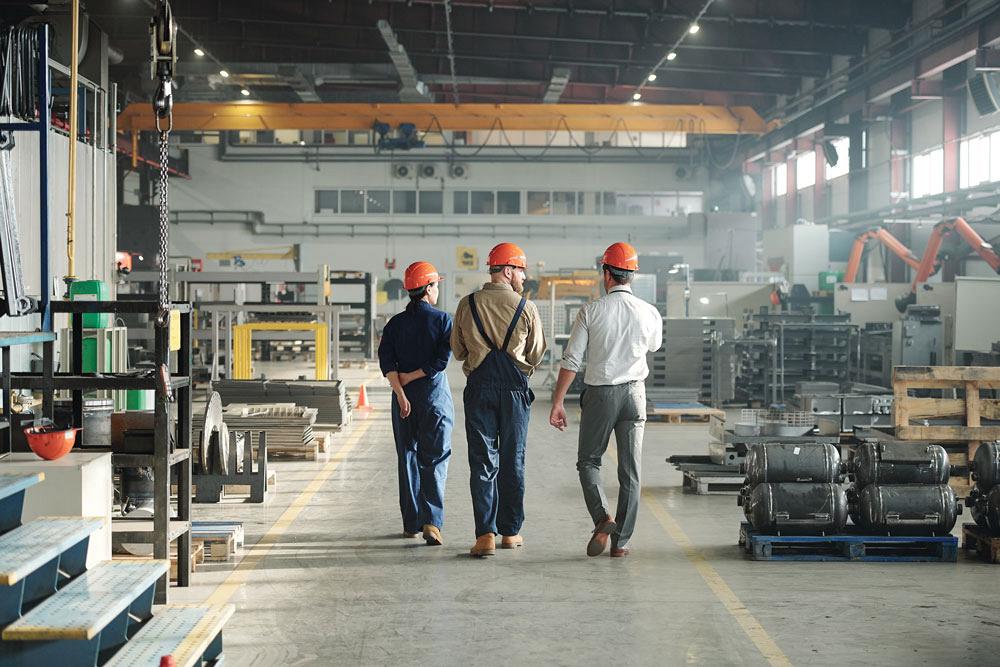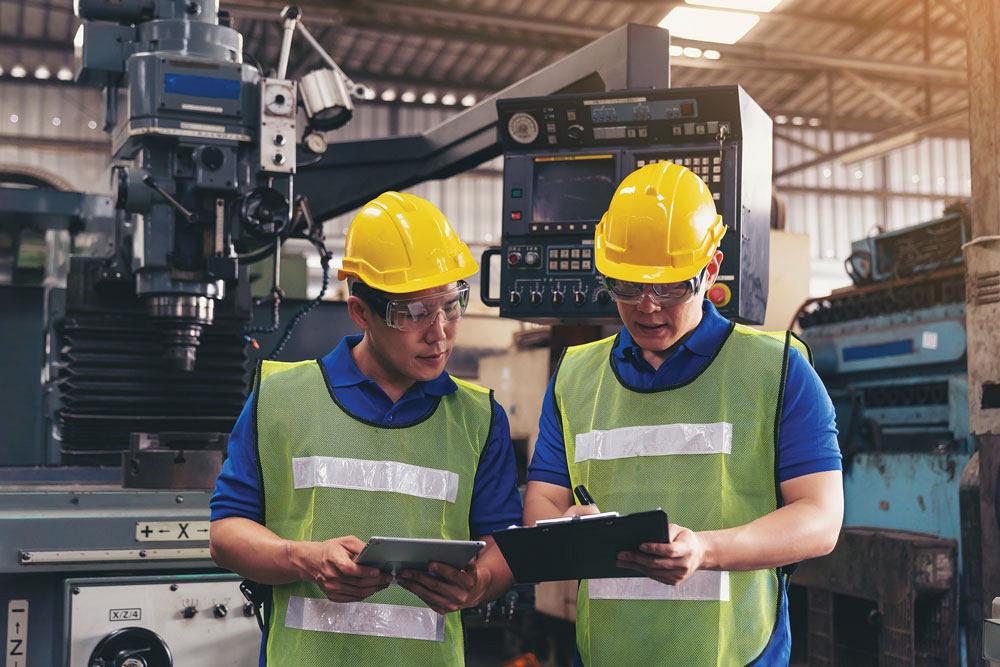Associate Editor
- FMA
- The Fabricator
- FABTECH
- Canadian Metalworking
Work safe, home safe
5 ways to improve health and safety on the shop floor
- By Lindsay Luminoso
- February 25, 2022
- Article
- Management

Any health and safety program needs to have buy-in from the top down, and it’s management’s responsibility to ensure workers know how it is being prioritized. Shironosov/iStock/Getty Images Plus
Work safe, home safe. This motto sums up what many workplaces are hoping to instill in their employees. Working safely encompasses so many different aspects of the workplace. It can mean having a clean workspace; following proper housekeeping procedures; eliminating physical, chemical, safety, or ergonomic hazards; and emphasizing wellness initiatives.
Shops looking to invest their time and money in a health and safety program can find a plethora of resources at their disposal. With wide-ranging information available, it might be difficult to know where to begin. Here are a few tips to get started.
Get Buy-in
First and foremost, any health and safety program needs to have buy-in from the top down. Management needs to ensure that workers know that health and safety is a priority. Having regular safety meetings, selecting safety representatives, communicating new and improved initiatives, and updating bulletin boards and signage regularly can get this message across.
“It's important to remember that health and safety shouldn't be a stand-alone thought,” said Riane Marrs, health and safety specialist, Canadian Centre for Occupational Health and Safety (CCOHS). “All owners, engineers, production managers, and supervisors need to integrate health and safety into everything that they do. As part of the program, there should be an opportunity for workers to participate through a health and safety committee or work health and safety representative.”
A good program will include roles and responsibilities for management and for workers. Managers should communicate hazards effectively. Doing this will help employees understand and see the value of working safely through implementing safe work procedures, workplace inspection, training, and reporting.
Follow Legislation
Whether a new shop is looking to develop a health and safety program or an existing shop wants to update an outdated policy, jurisdictional legislation is a good place to start. Many jurisdictions in Canada set out program requirements that need to be followed.
Different jurisdictions will have different posting requirements for mandatory signage. For example, provincial legislation, depending on the title of the workplace and the potential hazards, requires shops to have certain posters visible to workers. These can include certain Workers' Compensation Board or Workplace Safety and Insurance Board posters, names and contact info of health and safety committee members, violence prevention policy, and minutes of the most recent safety meetings. For a complete list of posting requirements, visit www.ccohs.ca/oshanswers/legisl/posting.html.
Communicate Effectively
Communicating health and safety initiatives should be both formal and informal and should include a number of stakeholders. Along with posters and signage, daily and direct communication will help demonstrate the significance and importance of a health and safety program.
Management should offer regular safety meetings and informal toolbox talks to better understand employee concerns and existing safety issues that arise.
“Having managers on the shop floor with the workers and leading by example will show employees that all levels of the organization are actively participating in health and safety,” said Marrs. “It's also a good opportunity for managers to have meaningful conversations with employees and explain the why behind the health and safety initiative. Doing this will not only help with buy-in; it can help increase employee engagement.”

With a risk or hazard assessment, a health and safety committee representative should go through the hazards and controls that can be put in place with workers associated with that task. Amorn Suriyan/iStock/Getty Images Plus
When employees take the time and are encouraged to inspect and maintain equipment and work safely, there can be less equipment downtime, fewer shutdowns related to the incident, and even increased employee morale and productivity.
Assess Risk
To assess risks, shops should look at all the different tasks undertaken and highlight any hazards in each task. Once identified, these risks can be ranked based on probability and outcome effect.
From there, members of the health and safety committee or representative should get involved and go through the hazards, as well as controls that can be put in place with workers associated with that task. Developing a worksheet that includes the task, who performs the task, potential hazards, and prevention procedures can provide the necessary information needed to keep workers safe.
After identifying potential risks and hazards, shops can also rank and prioritize them in a chart that is available for workers to view. This chart can also include colour coding that easily identifies the severity and ranking of each risk within the workplace.
“Shops need to make sure to highlight prevention,” said Marrs. “They shouldn’t be constantly reacting to hazards. If they are able to identify them early and control them before injury or incident, that would be the best. Creating clear instructions for workers to follow will help set a good tone for any workplace. CCOHS has some great resources and templates available to get shops started with any health and safety programs.”
Embed Safety
Having that safety embedded into all processes and programs, constantly sharing safety tests or training, and following safe work procedures will help make safety part of a shop’s everyday routine. It shouldn’t be an add-on thought but rather embedded in the culture of a machine shop.
When everyone works together to identify hazards and correct them, it can create a safer workplace for all. Management should encourage employees to take the time to follow safer procedures, maintain clean workstations, and report and correct any hazard. Management should also encourage the reporting of any incident, investigate to find the root cause, and implement corrective actions to ensure it doesn’t happen again.
“Prevention is key,” said Marrs. “A workplace shouldn't wait until an incident occurs for corrections to happen. It should always be looking ahead on how to improve, whether it's a process, training, communication, or any other element of the health and safety program.”
Associate Editor Lindsay Luminoso can be reached at lluminoso@canadianmetalworking.com.
Canadian Centre for Occupational Health and Safety, www.ccohs.ca
About the Author

Lindsay Luminoso
1154 Warden Avenue
Toronto, M1R 0A1 Canada
Lindsay Luminoso, associate editor, contributes to both Canadian Metalworking and Canadian Fabricating & Welding. She worked as an associate editor/web editor, at Canadian Metalworking from 2014-2016 and was most recently an associate editor at Design Engineering.
Luminoso has a bachelor of arts from Carleton University, a bachelor of education from Ottawa University, and a graduate certificate in book, magazine, and digital publishing from Centennial College.
subscribe now


Keep up to date with the latest news, events, and technology for all things metal from our pair of monthly magazines written specifically for Canadian manufacturers!
Start Your Free Subscription- Trending Articles
Automating additive manufacturing

Sustainability Analyzer Tool helps users measure and reduce carbon footprint

Sandvik Coromant hosts workforce development event empowering young women in manufacturing

GF Machining Solutions names managing director and head of market region North and Central Americas

Mitutoyo updates its end-user portal

- Industry Events
CTMA Economic Uncertainty: Helping You Navigate Kitchener Seminar
- May 2, 2024
- Kitchener, ON Canada
Automate 2024
- May 6 - 9, 2024
- Chicago, IL
ANCA Open House
- May 7 - 8, 2024
- Wixom, MI
17th annual Joint Open House
- May 8 - 9, 2024
- Oakville and Mississauga, ON Canada
MME Saskatoon
- May 28, 2024
- Saskatoon, SK Canada















